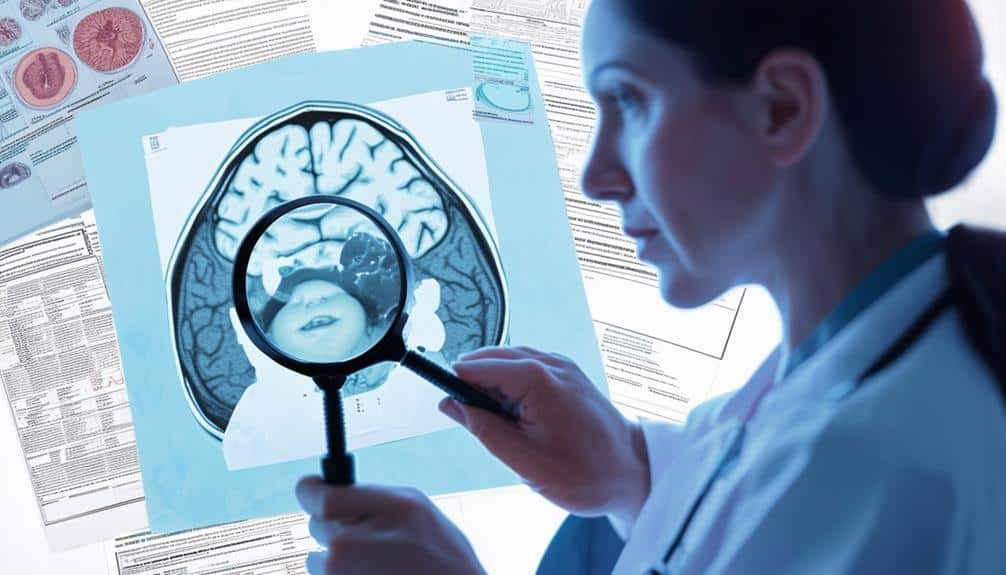Key Takeaways
- Early signs of autism in babies include diminished babbling, visual fixation on specific objects, and unusual sensory reactions.
- Language development indicators, such as limited vocalization and difficulty following instructions, could suggest autism.
- Behavioral signs, like adherence to routines and aversion to physical contact, can signal the need for further autism evaluation.
- Recognizing early signs and understanding unusual sensory reactions are crucial for timely intervention and support.
Recognizing Early Autism Clues
How can one distinguish the early indications of autism in babies and toddlers, specifically when these signs can often be subtle and easily missed? Precise observation and evaluation play a crucial role in identifying these initial cues.
Diminished babbling, or lack thereof, notably conversational babbling, is a fundamental indication. Additionally, visual differences, such as a distinct tendency to fixate on particular objects or stimuli, can be suggestive.
Uncommon reactions to tastes, textures, smells, and sounds might hint at potential autism. Moreover, rigid adherence to routines, distress over minor changes, difficulty in being comforted, and possible resistance to physical contact could be symptomatic.
Recognizing these signs early aids in initiating timely interventions, thus improving the developmental trajectory of autistic children.
Language Development Indicators
Specific developmental patterns in language acquisition can provide substantial indicators in early autism detection. These patterns often deviate from typical progress, and their identification can significantly assist in a timely diagnosis.
The following table outlines some key language development indicators associated with autism:
| Age | Typical Development | Warning Signs |
|---|---|---|
| 0-3 months | Cooing, smiling at people | Limited or absent vocalization |
| 4-6 months | Babbling, responsive to name | Infrequent babbling, lack of response to name |
| 7-12 months | Imitates sounds, uses gestures | Uncommon imitation, limited use of gestures |
| 1-2 years | Simple sentences, understanding instructions | Few words, difficulty following instructions |
| 2-3 years | Two-word phrases, interested in other children | Limited phrases, lack of interest in peers |
Identifying these signs can contribute to an early diagnosis, enabling adequate support and intervention strategies.
Behavioral Signs of Autism

Beyond language development indicators, specific behavioral signs also play a crucial role in the early detection of autism in babies and toddlers. An evident characteristic observed is adherence to routines; any slight deviation can cause distress.
Moreover, these children often struggle to be comforted, indicating a potential aversion to physical contact. Another noteworthy sign is diminished social interaction, including a lack of babbling, a fundamental early communication skill.
When combined, these symptoms present a compelling case for further evaluation of autism. Early detection is paramount, as it opens the gateway for early intervention. Caregivers and professionals should be vigilant in monitoring these behavioral signs in addition to language development indicators.
Understanding Unusual Sensory Reactions
Shifting our focus to sensory reactions, it becomes evident that infants and toddlers showing early signs of autism often exhibit distinct responses to various stimuli. These include unconventional reactions to food tastes or textures and a rare response to smells or sounds.
These sensory experiences can be overwhelming or underwhelming, leading to uncommon eating habits or sensory-seeking behaviors. For example, some children may demonstrate a heightened sensitivity to certain fabrics, causing discomfort in clothing selection, while others may show indifference to extremes in temperature or pain.
These responses, diverging from standard developmental patterns, can serve as early indicators of autism. Caregivers must accurately interpret and respond to these sensory cues to facilitate appropriate intervention strategies and enhance the child’s quality of life.
The Importance of Routine for Autistic Babies

For babies exhibiting early signs of autism, adherence to specific routines can become a significant aspect of their behavior, often serving as a pivotal indicator of their condition. This reliance on routine is not simply a preference but an essential coping mechanism for these infants.
Disruptions in routine can trigger significant anxiety and distress, hampering their ability to engage with their surroundings. From a scientific perspective, such behavior underscores the importance of predictability and order in their cognitive schema.
Therapeutically, it’s vital to maintain these routines while gently introducing changes to foster adaptability. Understanding the role of routine in an autistic infant’s life is essential for caregivers and health professionals, enabling them to support the child’s development effectively.
Why Early Diagnosis Matters
Understanding the pivotal importance of early diagnosis of autism in babies is essential, as it can significantly influence their developmental trajectory and overall quality of life. Detecting autism at an early stage can expedite the initiation of therapeutic interventions, which are most effective when implemented during the critical early years of neural plasticity.
This can help mitigate the core symptoms of autism, including social communication difficulties and repetitive behaviors. Additionally, early diagnosis can facilitate specialized educational programs, enhancing the child’s cognitive and social skills and improving long-term outcomes.
As a result, an early diagnosis provides a framework for understanding and supporting the child’s distinct needs. It shapes the child’s future and empowers them to reach their full potential.
Regular Check-ups and Autism Detection

In the field of early autism detection, routine well-child check-ups play an essential role by providing the opportunity for healthcare professionals to monitor a child’s developmental milestones and identify potential signs of Autism Spectrum Disorder (ASD).
These check-ups offer a structured framework for observing a child’s growth in critical areas such as language, social interaction, and behavior. Deviations from typical development patterns can be indicative of ASD. Pediatricians utilize standardized screening tools, such as the Modified Checklist for Autism in Toddlers (M-CHAT), to systematically assess these areas.
Through meticulous observation and analysis, physicians can detect early signs of ASD, facilitating prompt referral for diagnostic evaluation and intervention services. Thus, regular check-ups are paramount in the early detection and management of autism.
Resources for Understanding Autism
Exploring the intricacies of autism can be challenging. Hence, various detailed resources provide insights into understanding the disorder, its early signs, and the importance of early diagnosis.
The Autism Video Glossary, an online resource, offers visual descriptions of various autism symptoms.
The Early Childhood Evaluation Program (ECEP) provides an in-depth assessment protocol for potential ASD in young children.
The Centers for Disease Control and Prevention offers information on developmental milestones and ASD red flags.
Finally, the University of New Mexico’s Center for Development and Disability hosts Autism Programs offering further insights.
These resources collectively contribute to the understanding and early detection of autism, leading to timely intervention and improved outcomes.
About Maryann Trott

Leading the Autism Programs at the University of New Mexico, Maryann Trott, MA, BCBA, is prominent in autism research. It is known for her insightful contribution to developmental disabilities education.
Trott’s academic background, a Master’s degree in Applied Behavior Analysis, and her certification as a Behavior Analyst provide an empirical foundation for her work. She is lauded for her efforts in project management related to autism, reflecting her commitment to bettering the lives of those affected.
Her publications, under the University Center for Excellence in Developmental Disabilities Education, Research and Service, corroborate her deep understanding of the subject matter. Supported by various institutions, including the New Mexico Department of Health, Trott’s work continues to shape autism research and intervention, underscoring her dedication and expertise.
Evaluation Resources for Young Children
Identifying early signs of autism in children aged 0 to 3 requires using thorough assessment tools, such as the Early Childhood Evaluation Program (ECEP) and the resources offered by the Centers for Disease Control and Prevention. These tools provide a specialized approach to identifying developmental delays or disorders, enabling timely interventions.
| Assessment Tool | Description |
|---|---|
| Early Childhood Evaluation Program (ECEP) | A program focused on early detection of developmental disorders, including autism. |
| Centers for Disease Control and Prevention resources | Offers a detailed guide on developmental milestones, signs of autism, and screening for parents and healthcare providers. |
| Autism Video Glossary | A tool created to assist parents and professionals in understanding more about the early signs of autism. |
These resources empower parents and professionals to provide young children with the best care and support.
Frequently Asked Questions
What are effective strategies for managing autism in toddlers?
Practical strategies for managing autism in toddlers include early intervention programs, structured routines, visual aids for communication, and personalized therapy focused on enhancing social interaction, communication, and adaptive skills. Parental involvement is essential for progress.
How can parents support their child’s language development if autism is suspected?
Parents can support their child’s language development by engaging in regular, interactive communication, providing a language-rich environment, utilizing visuals, and seeking early intervention services from speech-language pathologists if autism is suspected.
What are the challenges in diagnosing autism in infants and toddlers?
Diagnosing autism in infants and toddlers presents challenges such as varying symptom presentation, overlap with other developmental disorders, and the subtlety of early signs, necessitating an all-encompassing and sensitive evaluation approach.
How does a child’s environment affect autism development?
A child’s environment can significantly influence the development or manifestation of autism. Factors such as exposure to stress, lack of social engagement, and limited access to early intervention services can exacerbate autistic symptoms.
What are common misconceptions about autism in infants and toddlers?
Common misconceptions about autism in babies and toddlers include the belief that all autistic people exhibit the same symptoms or that vaccinations cause autism. Parents need to seek accurate information.
Conclusion
In a world where early detection is crucial in managing autism, recognizing early autism clues in infants is essential. These clues include subtle differences in behavior, social communication, and sensory responses, which are crucial for timely intervention. Studies have shown that early intervention can significantly improve the development and social skills of children with autism spectrum disorders.
Recognizing early autism clues can lead to better outcomes for your child. Look for signs such as speech delay, limited eye contact, and unusual reactions to sensory stimuli. Identifying these signs in the first few months of life allows for earlier assessment of autism and appropriate therapeutic interventions. Research in the Journal of Autism and Developmental Disorders highlights the importance of early diagnosis and intervention for children with autism.
Pay attention to your baby’s motor skills, social behavior, and communication skills, which are essential. Children with autism spectrum disorders may show signs of developmental delays, such as repetitive behaviors and difficulties with joint attention. By understanding and monitoring these early autism clues, parents can help their children develop crucial skills and improve their quality of life.
Regular check-ups and developmental surveillance play a vital role in detecting early signs of autism. Healthcare professionals can guide you in recognizing and understanding these early autism clues, leading to a more informed and supportive approach to your child’s development. With early intervention and support, children with autism can reach their full potential and thrive.


Recent Comments